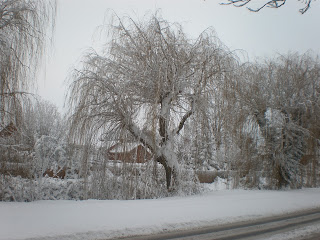 |
| Not a car in sight - a very quiet neighbourhood, Old Independent church in the background, Victorian cottages (1896) on the right |
In the outlying villages such as Hundon they may even be cut off. The land around the villages in this part of Suffolk is the highest in the county, all of 116m above sea-level. It is also surprisingly rolling in nature. This is near the lower limit that 20,000 years ago glacial ice sheets pushed down into what later became the UK. Many of the roads in this part of the Suffolk are actually below the level of the fields. In snowy conditions this often leads to hardly any snow on the fields but roads that are impassable due to 4 to 5 feet of snow.
Impassable roads in the rural context of the farming communities of the past was not a big problem as people did not generally travel far out of their villages in winter. the services that they needed were local. The butcher, baker, and general grocers were still to be found in many villages into the 1940s and even 1950s in Suffolk. If weather did come along the "distribution centres" were local. We now have the economy of scales that make supermarket shopping the only oprion, but in winter conditions very hit and miss because of transport issues. Speculation on supply and demand is rife at the moment in the UK with heating oil a major problem for a lot of rural dwellers. Reports of rise of up to 100% in prices compared to a few months ago are reported daily upon the news. That is assuming that supplies can be had for immediate delivery. Reports of 4 week delays are common. Thefts of heating oil are on the increase. We are not talking about the odd litre here or there in a small can, but equivalent of a small tanker disappearing. But then again apparently road salt is being stolen and then sold on the black market. I doubt though these are so called lovable rogues (if they ever were) of folk memories. This could see a small return to a use of coppiced wood (a sustainable and carbon neutral fuel) for heating, or an increase in the sale of woolly jumpers.
The amount of coppiced woodland is relatively small compared to before the intensification of farming. Hedges no longer ring fields so potential for wood from the odd tree here is also restricted. The people capable of also harvesting wood without killing the tree are also in short supply. So a machine to make compressed paper bricks might be the answer, especially, at Christmas when there is all that paper about to be shredded.
 |
| Stourbrook flowing through Haverhill |
The brook ran through the water meadows as were until the expansion of the town in the mid to late 1950s and early 1960s. A friend of mine whose family were local butchers and farmers could trace their ownership of the land back to the 1750s. When the butchery business closed I photographed the documents one Easter. The documents were on parchment (cured animal skins) that did actually almost crackle with age as they were gently smoothed flat.
The land that was to the left of the brook was owned by the Sainsbury family of supermarket fame and then transferred to a friend's family at about the 1780s, ( I will have to check this date) on which cattle were grazed in the summer. The Sainsbury family have many connections with this part of Suffolk, owning at one point the house that was the dairy in Kedington, just over the next hill. Sadly my friend is a part of old Haverhill that is no longer with us, but the documents are apparently still in the family and being cared for.
The right bank of the brook was up until recently a dairy. Manor Farm is now a housing development which according to the Environment Agency map is at risk of flooding. This is built upon the flood "plain" which even I can remember seeing cattle upon. Haverhill has had some very notable floods in it's time which I will go further into at another time.
I have given a small insight into views of Haverhill in the snow. I have not had as much chance to write about food this week but hopefully my BT Internet finally, will be up and running tomorrow. With time in front of the screen I will write a little more of the food of Suffolk and how it has influenced some of the traditions of the older members of Haverhill that have been born and bred here, as have their families before them. This is the season of roasted meats. Turkey has not always been the traditional meat of celebration. That is equally true of other places. another place of interest to me is Crete. The main festive meat this time of year being Pork. Pork is a meat long grown and used in Suffolk. Suffolk Black Hams of which I will write later in the week are a speciality that takes preparation and also planning if you are to have it as part of your festive fare.
So final shot of snowy Haverhill.......


No comments:
Post a Comment